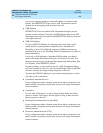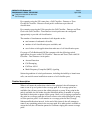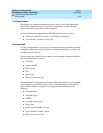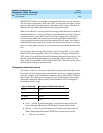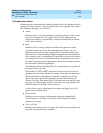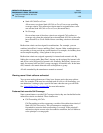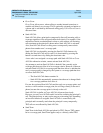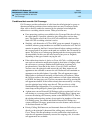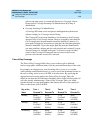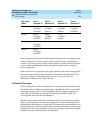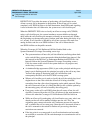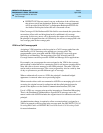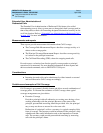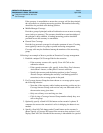
DEFINITY ECS Release 8.2
Administrator’s Guide
555-233-506
Issue 1
April 2000
Features and technical reference
1207Call Coverage
20
Conditions that override Call Coverage
Call Coverage provides redirection of calls from the called principal or group to
alternate answering positions when certain criteria are met. Certain provisions
allow calls to direct to and/or be answered by the principal even though the
redirection or overriding criteria are met. These provisions are:
■ If no answering positions are available in the Coverage Path, the call rings
the called phone, if possible; otherwise, the calling party receives busy
tone. This applies even if the Cover All Calls redirection criterion or the
Send All Calls overriding criterion is active.
■ Similarly, calls directed to a UCD or DDC group are queued, if queuing is
available, when no group members are available to answer the call. The call
remains in queue for the Don’t Answer Interval before routing according to
the coverage path. If no points on the path are available, the call remains in
queue. The worst case is when group queuing and the coverage points both
are unavailable. In this case, the caller receives busy tone or ringback,
depending on the type of trunk carrying the call.
■ If the redirection criterion is Active or Cover All Calls, a called principal
can receive a redirection notification signal (a short burst of ringing) when
the call routes to coverage. (Redirection Notification is optional on a
per-phone basis.) Note that in the Active, Cover All Calls, and Don’t
Answer cases, the principal could answer the call. Busy means no call
appearances are available to answer the call. Redirected calls maintain an
appearance on the called phone, if possible. The call appearance status
lamp flashes to indicate an incoming call before the call redirects. When
the call does redirect, the status lamp continues to flash (when redirecting
to AUDIX, the lamp goes out). The user can answer the call by pressing the
call appearance button. If the call has already been answered by a covering
user, the principal may bridge onto the call. This provision is called
Simulated Bridged Appearance. If a covering user answers the call, the
status lamp on the principal’s phone lights steadily.
■ A phone user can use Directed Call Pickup to pick up a principal’s call or a
call alerting at a coverage point. Directed Call Pickup allows a phone user
to answer an alerting call from any station on the DEFINITY ECS. That is,
the alerting and answering stations do not need to be members of the same
Call Pickup group. You enable and disable Directed Call Pickup on a
system-wide base. However, permission to use the feature can be allowed
or disallowed based on COR.
■ Priority Calling, Dial Intercom, and Automatic Intercom Calls always route
directly to the principal’s phone until the calling party activates Go to
Cover. These calls take precedence over the redirection criteria and can
seize the call appearance normally reserved for outgoing calls, if no other
call appearances are available.



